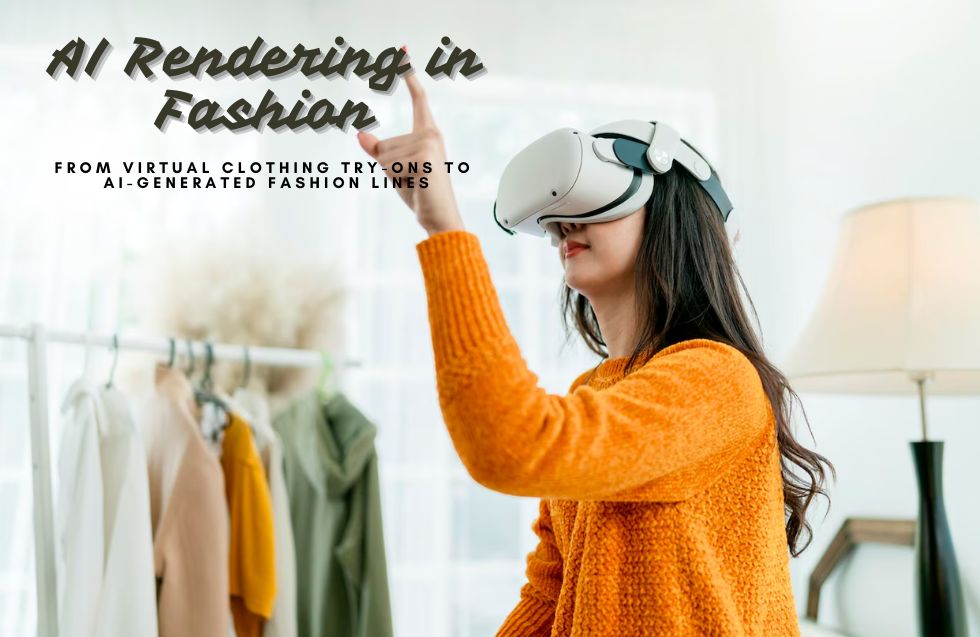The fashion industry is undergoing a technological revolution, and artificial intelligence (AI) is at the heart of this transformation. AI rendering is reshaping the way we shop, design, and even experience fashion, making it more efficient, personalized, and sustainable. From virtual clothing try-ons that allow customers to see how garments fit without stepping into a physical store to AI-generated fashion lines pushing the boundaries of creativity, this cutting-edge technology is redefining the industry. In this blog, we explore how AI is transforming fashion, from predictive trends to virtual runways, along with the stats and facts to back it up.
1. Virtual Clothing Try-Ons: A Game-Changer in Online Shopping
Online shopping has long posed challenges, particularly with the difficulty of determining the right fit without trying clothes on physically. However, AI-powered virtual clothing try-ons are solving this problem by allowing consumers to “try on” clothes digitally, creating a seamless and interactive shopping experience.
AI algorithms use computer vision and machine learning to map the user’s body, allowing them to visualize how garments will look on them in real-time. For example, platforms like Zeekit and Fit Analytics enable users to upload a photo of themselves and try on digital versions of clothes. The AI maps the clothing onto the user’s body shape, ensuring the accuracy of fit, fabric flow, and lighting.
Stats to highlight:
- According to GlobalData, 35% of consumers reported they are more likely to shop online if virtual try-on technology is available.
- Virtual try-on platforms have helped reduce returns by up to 25% due to better-fit prediction (Narvar).
- Brands using virtual try-ons have seen conversion rates increase by an average of 22%.
2. AI-Generated Fashion Lines: Creativity Meets Technology
AI-generated fashion lines are pushing the boundaries of creativity by enabling machines to co-create with designers. Using vast datasets of fashion trends, historical designs, and customer preferences, AI systems can generate entire clothing collections. These systems speed up the design process while fostering fresh, innovative ideas that might not have occurred to human designers.
One brand pioneering this movement is The Fabricant, a digital-only fashion house that creates garments purely in the virtual world. AI-generated fashion has also found a foothold with more traditional brands like Tommy Hilfiger, which have started experimenting with AI tools to develop new lines faster and more efficiently.
Key stats:
- AI-assisted fashion design can reduce the time to market by 30-50%, according to McKinsey.
- The AI-driven fashion design market is expected to grow at a rate of 39% annually through 2027 (Global Market Insights).
3. Predicting Fashion Trends: AI’s Forecasting Power
One of the most powerful applications of AI in fashion is its ability to predict future trends. AI can analyze vast amounts of data, from social media posts to fashion show images, and detect emerging patterns long before they become mainstream. This gives brands a significant competitive advantage, allowing them to produce on-trend collections that are more likely to resonate with consumers.
Heuritech, for instance, analyzes millions of Instagram and Pinterest posts to forecast trends up to 12 months in advance. By predicting what styles, colors, and designs will be popular, fashion brands can optimize their production, minimizing overproduction and unsold inventory.
Key stats:
- Brands leveraging AI for trend forecasting can improve accuracy by 85% (McKinsey).
- AI could help reduce overproduction in the fashion industry by 10-15%, contributing to sustainability efforts.
4. Virtual Runways: Fashion’s New Digital Stage
Fashion shows, once exclusive in-person events, are also being transformed by AI. Virtual runways allow designers to showcase their collections digitally, creating immersive experiences for global audiences. AI-rendered models, like the world’s first digital supermodel Shudu, have become an integral part of virtual fashion shows, demonstrating how technology can push the boundaries of what’s possible in fashion presentations.
Balenciaga is one brand that embraced this trend early, hosting a fully AI-rendered virtual runway show in 2020. Virtual runways offer multiple benefits: they are more cost-effective, allow for global participation, and eliminate the need for physical venues, cutting down on the environmental impact of traditional shows.
Stats to consider:
- Virtual fashion shows cost 70% less than traditional runways (FashionUnited).
- 85% of fashion professionals believe virtual runways will remain an important part of the industry, even post-pandemic (BoF Insights).
- In a GlobalData survey, 90% of digital fashion show attendees preferred interactive elements like zooming in on designs over traditional, in-person shows.
5. AI for Sustainable Fashion
Sustainability is a growing concern for the fashion industry, which is responsible for approximately 10% of global carbon emissions. AI is helping to address this issue by optimizing production, minimizing waste, and promoting more sustainable practices. For instance, AI tools can accurately predict demand, allowing brands to only produce what is needed, thus reducing fabric waste and unsold inventory.
Moreover, virtual sampling is replacing physical prototypes, allowing designers to refine their work digitally before going into production. This not only saves resources but also significantly reduces environmental impact.
Key sustainability stats:
- AI can help reduce textile waste by up to 21 million tons annually (Euratex).
- AI adoption in fashion could help the industry cut greenhouse gas emissions by 30% by 2030 (Boston Consulting Group).
6. Enhanced Personalization Through AI
Personalization is a key trend in modern fashion, and AI is helping brands deliver hyper-customized experiences for their customers. By analyzing data such as browsing history, previous purchases, and social media activity, AI algorithms can recommend clothing that aligns with individual tastes and body types. Stitch Fix, for example, uses AI-powered recommendations to create personalized style boxes for its customers.
This level of personalization strengthens customer relationships, enhances satisfaction, and drives brand loyalty.
Stats to consider:
- 91% of consumers are more likely to shop with brands that offer personalized recommendations (Accenture).
- AI-driven personalization can boost sales by 10-30%, according to McKinsey.
Conclusion: The Future of Fashion with AI Rendering
AI rendering is transforming every aspect of the fashion industry, from how we try on clothes to how designers create entire collections. The integration of AI into fashion is driving innovation, improving customer experiences, and contributing to more sustainable practices.
From virtual try-ons that enhance online shopping to AI-generated fashion lines that redefine creativity, the future of fashion is becoming increasingly digital. As AI continues to evolve, fashion brands that embrace this technology will lead the way in shaping the industry’s future. With AI’s ability to predict trends, optimize production, and enable virtual fashion shows, we are entering an exciting era where the boundaries of design and experience are constantly expanding.












